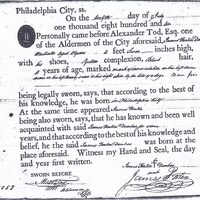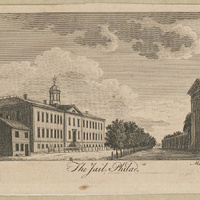 Seamen's Protection Certificate for James Forten Dunbar (1810) Seamen's Protection Certificate for James Forten Dunbar (1810) |
|
Seamen's Protection Certificates were documents authorized by an act of Congress in 1796 to protect U.S. sailors from being impressed into the service of foreign navies. For Black Americans, they also served as a way to document their free status. This certificate was issued for James Forten Dunbar, a free man of mixed ancestry who spent a long career at sea as a sailor and sail-maker aboard merchant and naval vessels, including service in the U.S. Navy during the Civil War.
|
 Sedition Act (1798) Sedition Act (1798) |
|
This is one of four acts known collectively as the Alien and Sedition Acts. These acts were passed by a Federalist-controlled Congress applied restrictions to immigration and speech in the U.S. They were highly controversial and contributed to the Federalist defeat in the election of 1800. After 1802, only the Alien Enemies Act remained in force, and has continued to be invoked during times of war. The Sedition Act made it illegal to print "false, scandalous and malicious writing" against the U.S. government. It was used to suppress speech critical of the Federalist Party.
|
 She's Been Her Own Mistress: The Long History of Charlotte Dupee v. Henry Clay, 1790-1840 (2020) She's Been Her Own Mistress: The Long History of Charlotte Dupee v. Henry Clay, 1790-1840 (2020) |
|
This essay refocuses the story of Charlotte Dupee v. Henry Clay on Charlotte herself, detailing her long struggle navigating the strategies and pathways to freedom.
|
 Stowage of the British slave ship "Brookes" under the Regulated Slave Trade Act (1788) Stowage of the British slave ship "Brookes" under the Regulated Slave Trade Act (1788) |
|
This image was used by English abolitionists to demonstrate the terrible conditions aboard slave ships.
|
 The Cherokee Removal Through the Eyes of a Private Soldier (1890) The Cherokee Removal Through the Eyes of a Private Soldier (1890) |
|
A former Army soldier presents a first-hand account of Cherokee removal.
|
 The Slave, Grace (1827) The Slave, Grace (1827) |
|
In this freedom suit, an enslaved woman who had spent time in England was re-enslaved once she voluntarily returned to her home in Antigua. The court found that while she became free once she set foot on English soil, her status reverted to that of enslaved once she returned to Antigua.
|
 The Timing of Queen v. Hepburn: An exploration of African American Networks in the Early Republic (2015) The Timing of Queen v. Hepburn: An exploration of African American Networks in the Early Republic (2015) |
|
This essay explores the phenomenon of multigenerational networks of freedom-making through the petition for freedom cases of the Queen family in Washington, D.C.
|
 Treaty of Amity, Commerce and Navigation (1794) Treaty of Amity, Commerce and Navigation (1794) |
|
Unpopular with the American public, this treaty between the United States and Britain attempted to resolve outstanding issues from American independence. This treaty, also known as John Jay’s Treaty, made trade between the two countries more even and reduced British military presence in the U.S.
|
 Treaty of Paris (1783) Treaty of Paris (1783) |
|
The Treaty of Paris was signed by the United States and Britain in 1783 to end the American War for Independence (1775- 1783). It recognized the United States as an independent state and delineated the Western boundaries of the new country.
|
 Treaty of San Lorenzo (1795) Treaty of San Lorenzo (1795) |
|
Also referred to as Pinckney's Treaty after the U.S. official who negotiated it, this treaty settled the borders between the United States and the Spanish colony of Florida as well as provided guidelines for future navigational disputes. Pinckney's Treaty was later referenced in the 1841 Amistad case when Spanish officials demanded the return of the Africans on board the ship as "property" seized by Americans on the high seas, per Article IX of the treaty.
|
 U.S. Constitutionalism and Native American Sovereignty U.S. Constitutionalism and Native American Sovereignty |
|
This teaching module discusses the centrality of Native people and their nations throughout American history, featuring a webinar with Ned Blackhawk, author of the 2023 book, The Rediscovery of America: Native Peoples and the Unmaking of U.S. History.
|
 Unis et al. v. Charlton's Administrator et al. (1855) Unis et al. v. Charlton's Administrator et al. (1855) |
|
In this freedom suit, the descendants of a Black woman named Flora claimed their freedom on the grounds that Flora was free before being abducted and sold into slavery in Virginia. Between 1826-1855, a series of cases bounced around county and appellate courts in Virginia before finally being decided against freedom for Flora's descendants.
|
 Walnut Street Prison (1789) Walnut Street Prison (1789) |
|
An etching of the Walnut Street Prison in Philadelphia. Established as a city jail in 1773, it was expanded in 1790 to become the first state penitentiary in the new country. This prison was among the first to feature individual cells and was built to accommodate work details. The penitentiary was noted to have a larger percentage of Black inmates than white, noting the racialization of incarceration in the United States. The prison was in operation until 1838.
|
 Webinar - Equal Protection, Reconstruction, and the Meaning of the 14th Amendment (2023) Webinar - Equal Protection, Reconstruction, and the Meaning of the 14th Amendment (2023) |
|
In this webinar, Dr. Kate Masur of Northwestern University discusses the 14th Amendment and the implications of equal protection under the law with Dr. Sharlene Sinegal-DeCuir of Xavier University and Dr. William Thomas and his American Constitutional History class.
|
 Webinar - U.S. Constitutionalism and Native American Sovereignty (2023) Webinar - U.S. Constitutionalism and Native American Sovereignty (2023) |
|
In this webinar, Professor Ned Blackhawk of Yale University discusses his recent book The Rediscovery of America: Native Peoples and the Unmaking of U.S. History, which argues for the centrality of Native people and their nations throughout American history from the colonial era to the present, as well as tribal sovereignty and federal Indian law in the United States.
|
 Winny v. Phebe Whitesides alias Prewitt (1824) Winny v. Phebe Whitesides alias Prewitt (1824) |
|
This case was the first freedom suit heard by the Missouri Supreme Court. Winny claimed her freedom on account of being brought into the free territory of what would become Illinois before being removed to Missouri. The court found in favor of her freedom, establishing a "once free, always free" precedent that was eventually overturned by the decision in Dred Scott v. Sandford.
|
 Seamen's Protection Certificate for James Forten Dunbar (1810)
Seamen's Protection Certificate for James Forten Dunbar (1810) Sedition Act (1798)
Sedition Act (1798) She's Been Her Own Mistress: The Long History of Charlotte Dupee v. Henry Clay, 1790-1840 (2020)
She's Been Her Own Mistress: The Long History of Charlotte Dupee v. Henry Clay, 1790-1840 (2020) Stowage of the British slave ship "Brookes" under the Regulated Slave Trade Act (1788)
Stowage of the British slave ship "Brookes" under the Regulated Slave Trade Act (1788) The Cherokee Removal Through the Eyes of a Private Soldier (1890)
The Cherokee Removal Through the Eyes of a Private Soldier (1890) The Slave, Grace (1827)
The Slave, Grace (1827) The Timing of Queen v. Hepburn: An exploration of African American Networks in the Early Republic (2015)
The Timing of Queen v. Hepburn: An exploration of African American Networks in the Early Republic (2015) Treaty of Amity, Commerce and Navigation (1794)
Treaty of Amity, Commerce and Navigation (1794) Treaty of Paris (1783)
Treaty of Paris (1783) Treaty of San Lorenzo (1795)
Treaty of San Lorenzo (1795) U.S. Constitutionalism and Native American Sovereignty
U.S. Constitutionalism and Native American Sovereignty Unis et al. v. Charlton's Administrator et al. (1855)
Unis et al. v. Charlton's Administrator et al. (1855) Walnut Street Prison (1789)
Walnut Street Prison (1789) Webinar - Equal Protection, Reconstruction, and the Meaning of the 14th Amendment (2023)
Webinar - Equal Protection, Reconstruction, and the Meaning of the 14th Amendment (2023) Webinar - U.S. Constitutionalism and Native American Sovereignty (2023)
Webinar - U.S. Constitutionalism and Native American Sovereignty (2023) Winny v. Phebe Whitesides alias Prewitt (1824)
Winny v. Phebe Whitesides alias Prewitt (1824)